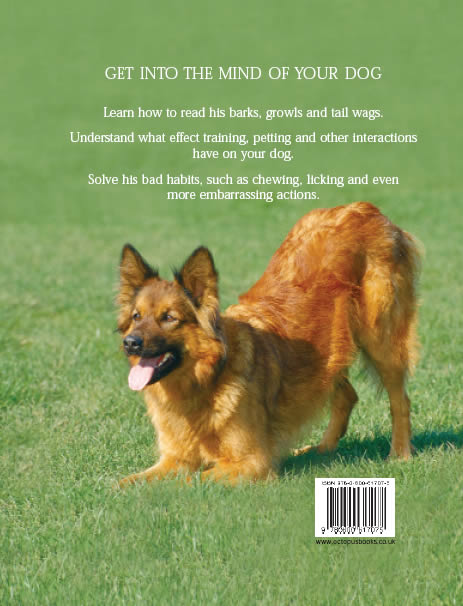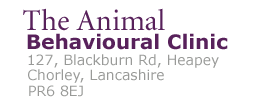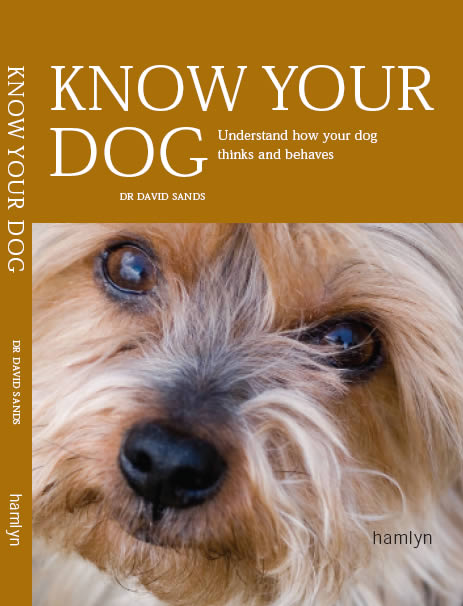
Why does your dog bark at strangers and lick your face?
Unlock the mysteries of your dog’s behaviour with this practical, information-packed book and truly
get to understand your dog’s mind.
- Learn how to read his barks, growls and tail wags.
- Understand what effect training, petting and other
interactions have on your dog.
- Solve his bad habits, such as chewing, licking and
even more embarrassing actions.
- Read special features on the latest canine research
and behavioural science.
Format: 273 x 216 mm (81/2 x 103/4 in)
Extent: 160 pages
Binding: hardback
Words: 40,000
Photographs: 160
Price: £14.99
Publication: August 2008
Dr David Sands is a leading animal behaviour
counsellor specializing in the treatment of dogs,
cats, birds, horses and exotic pets. He is an
internationally established pet author whose books
include The Family Dog and Cats: 500 Questions
Answered.
Other titles in the series:
Know Your Horse
Know Your Cat
Contents
Understanding your dog - 8
Wolf ancestry • Anatomy • The senses • How
dogs think • The social pack • Personality
Reading your dog - 26
Early life • Licking, scratching and chewing •
Body postures • Bark, growl and yelp • Breedspecific
behaviour
Day-to-day life - 40
Sleep • Grooming • Play • Male and female
attitudes
Puppyhood - 54
A puppy’s eye view • Physical and sensory
development • Weaning • Testing and challenging
• Stealing • Neutering and its effects • Training
In the home - 74
Interactive behaviour • Visitors in the home •
Visiting family and friends • Behaviour with toys •
Territorial-marking and alert barking • Diet and
behaviour • At the kennels • Moving house
Out and about - 92
Meeting other dogs • Meeting strangers and
children • Selective hearing • Recall and flight
response • How dogs view traffic • Scavenging •
In the car • Veterinary-related behaviour • Fear
and hyperactivity
Bad dog - 114
Recognizing fear and stress • Over-dependency •
Separation-related disorder • Sound sensitivity •
Aggression • Obsessive behaviour • Faeces-eating
• Hiding away • Weight problems • Overprotectiveness
• Fear of strangers and other dogs
Health - 144
Warning signs • The pregnant bitch • The aging
dog • Canine incontinence • Infirmity
Index 157
Petting your pet
Most of the time your dog just wants to be
part of your social scene and craves physical
contact. When you reach down to pat and
stroke him he views this as his pack leader
giving him some much desired attention and
this contact is extremely reassuring for him.
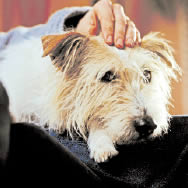 Your dog can use physical contact as the first step to gaining
more attention from you. He sniffs and licks your hands,
encouraging you to become even more involved. It takes only
a glance and tail wag from him for you to switch from patting
to stroking to a close cuddle. Maybe it will lead to your dog
being offered a walk or some food. Either way, the interaction
is sociable and that pleases both sides.
Your dog can use physical contact as the first step to gaining
more attention from you. He sniffs and licks your hands,
encouraging you to become even more involved. It takes only
a glance and tail wag from him for you to switch from patting
to stroking to a close cuddle. Maybe it will lead to your dog
being offered a walk or some food. Either way, the interaction
is sociable and that pleases both sides.
Your side of this is enjoying contact with your dog. Humans
show affection through tactile gestures too and we pat a dog
in much the same way we would pat a child’s head.
Puppies
It doesn’t take long for your dog to learn that a ‘happy dog’
approach – tail wagging, mouth open and eyes wide and
eager – will earn him lots of attention from you and your
family. Puppies, in particular, will crave reassurance from
physical contact soon after removal from the litter mother and
siblings and learn how to get it quickly. A puppy will enjoy
plenty of contatct with you, especially prior to sleep periods,
because your warmth has the same soothing effect as the
closeness he enjoyed with his litter mother and siblings.
Grooming
Your dog also sees stroking as part of a natural grooming
behaviour. Even rougher contact is viewed as desirable. Try
holding his scruff and gently rubbing behind the head, under
the chin and on his ears. These are very difficult for a dog to
groom himself and he will offer himself to encourage your
playful scratching and rubbing of these regions. Your
willingness to scratch into his scruff (an act that mimics the
mother carrying her puppies by the looser skin around the
neck) together with any rubbing or tickling you give him is
not very different from canine allogrooming – social
grooming – behaviour.
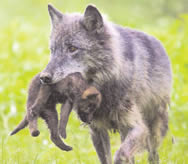
Wolf cubs can be carried to safety
by the ‘soft’ jaws of an adult when
threatened. This behaviour has found it’s
way into the domestic dog’s genes and
contact around the scruff and back is
welcomed by the ‘wolf’ in your home.
Allogrooming
Social grooming in animals is known as allogrooming. In
nature, dogs groom each other exclusively through licking
and this behaviour is part of the process of sociability and
trust. This behaviour is thought to act as a form of
appeasement in most social animals and has a role in
reducing tension and conflict among groups.
A key concept of allogrooming is submission to the dominant
pack member. When your dog rolls over and offers his tummy
he is being submissive. The reward of receiving a playful rub
here is more than enough to encourage your dog to repeat
this act of submission to gain the benefit. In nature, the
vulnerable underbelly and genitals may be presented to a
trusted pack member for sniffing and grooming.
Hormones
Your dog also has a chemical reason to enjoy a nice petting
session with you. Mimicking grooming behaviour has a
soothing effect because it triggers the release of hormones
into your dog’s brain. There are three key hormones that
are triggered:
endorphins – blocking stress, pain and irritations
dopamine – released by the feeling of anticipation triggered
by pleasure and soothing contact
serotonin – released as a specific reward giving a feel-good
factor.
All these hormones are linked to the brain stem and
hypothalamus, which deals with pain, arousal and pleasure.
This region in the brain is also linked to addiction, obsession
and compulsion. When he self-grooms your dog triggers these
major hormones and this can sometimes lead to excessive
grooming in times of stress.
WHAT ARE THE HUMAN BENEFITS TO STROKING A DOG?
When you stroke your dog it creates
a positive effect on your heart’s
metabolism and triggers the release of
the same wonderful reward hormones
that also help to make you content.
Dog ownership has been proven to
relax people, reducing their blood
pressure and even helping to counter
depression. Patients suffering from
heart conditions, hypertension,
diabetes and many other chronic
conditions have shown improvement
in health when caring for a dog.
There are schemes in the US –
Animal Assisted Therapy Programme
– and the UK – Pets as Therapy– that
work with this benefit and take dogs
into retirement homes, hospices and
hospital wards.
Having a dog is good for the head as
well as the heart. Psychologists agree
that children involved in caring for a
dog will improve their IQ as well
increasing their responsibility and
respect for animals.
Licking your face
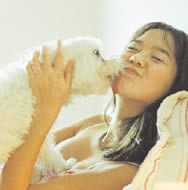 You’ve returned from a shopping trip with a
friend and there, with an enthusiastic
welcome, is your faithful dog. You both kneel
down to say ‘hello’ and your dog begins to
vigorously lick yours and your friend’s faces.
You love your dog but you find his behaviour
a bit embarrassing.
You’ve returned from a shopping trip with a
friend and there, with an enthusiastic
welcome, is your faithful dog. You both kneel
down to say ‘hello’ and your dog begins to
vigorously lick yours and your friend’s faces.
You love your dog but you find his behaviour
a bit embarrassing.
Why does he do this?
When your dog attempts to lick your face he’s performing a
canine greeting commonly observed in the wild. In nature,
juveniles and the dominant female that has remained behind
to care for her cubs will enthusiastically greet the returning
pack members that have been out hunting and foraging. The
youngsters and other hungry individuals will jostle with each
other and try to lick a hunter-pack member around the neck,
throat and mouth regions as a form of begging behaviour.
Those returning pack members that have eaten prey will often
use this interaction as a signal to regurgitate partially digested
food because they have an innate or genetic response to this
submissive behaviour.
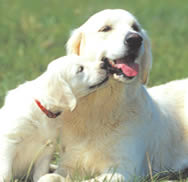
Puppies love facial contact with
thier mother. In the wild this is a simple
way to stimulate a feed or pay homage to
the pack leaders returning from a hunt.
So when your dog licks your face he’s acting out a natural
greeting to his ‘pack leader’. It is not therefore a ‘kissing’
greeting full of adoration, but genetically programmed
behaviour used to gain food from the male hunters.
What to do
If you think face licking is unhygienic and even embarrassing
then you need to put a stop to the habit at an early age. If a
dog is talked to or interacted with in any way, this will simply
encourage the behaviour and the longer it goes on the harder
it will be to stop.
You need to reward your dog when he’s sitting quietly. This
applies not only to when he comes to the door, but to any
time when he’s climbing on you or jumping up at you. As
soon as he stops, reward him. The more often a dog sees that
this is beneficial the more likely your dog will view face
licking as undesirable and the behaviour will stop.
QUESTIONS
What should I do when a new puppy first starts
face-licking?
Turn away without speaking or giving eye contact and,
as soon he stops praise him and give him a quick pat.
Your puppy will quickly learn that he can get attention
from you without resorting to licking.
Make sure friends, family and regular visitors are asked
not to indulge the puppy when he tries to jump up. Any
alteration in instructions will either confuse your dog or,
worse, undermine your authority.
Is the behaviour detrimental to the dog?
Some insecure dogs become addicted to licking
behaviour and, in moments of stress such as separation
from their owner, they will repeatedly lick a paw or flank.
If this behaviour progresses it can lead to the
development of fungal infections and lick granulomas
that may require both professional behaviour and
veterinary treatment.
Is the behaviour a health risk to humans?
There is a risk to humans in situations where dogs pick
up infections after coming into contact with other dogs
or animal faeces and then transfer unhealthy bacteria to
owners. In most cases it is a low risk, but you should
consider this when encouraging face-licking behaviour.
